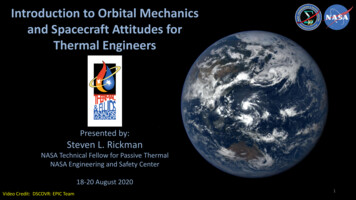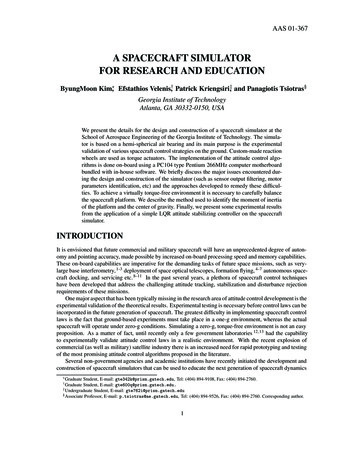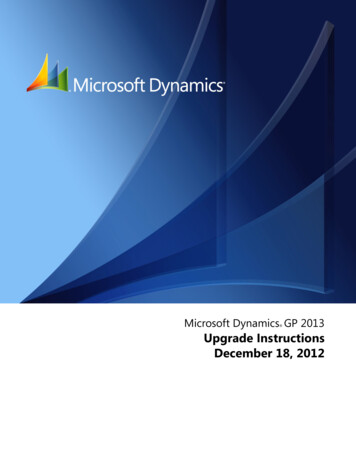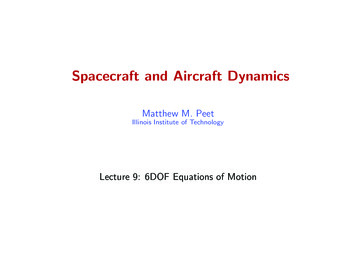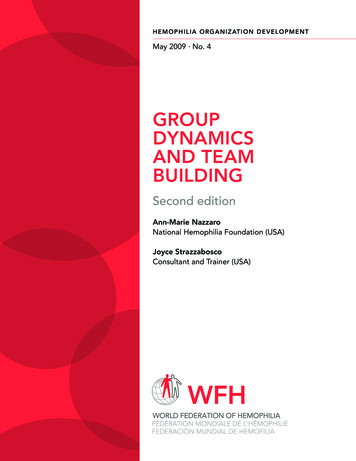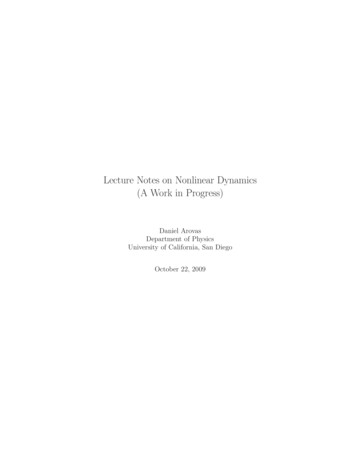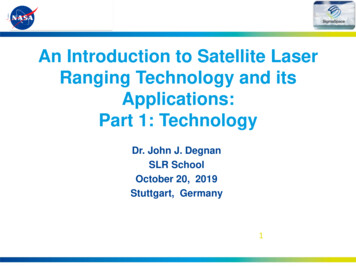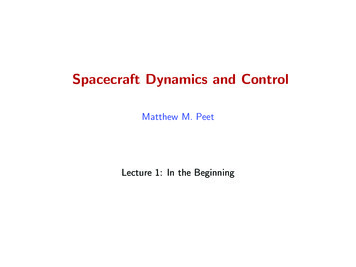
Transcription
Spacecraft Dynamics and ControlMatthew M. PeetLecture 1: In the Beginning
Who Am I?Website: http://control.asu.eduResearch Interests: Computation, Optimization and ControlFocus Areas:Expertise: Control of Nuclear Fusion Control of Delayed Systems Immunology Control of PDE Systems Soft Robots Satellite Attitude Dynamics Control of Nonlinear Systems Optimization Machine LearningMy Background: B.Sc. Aerospace Engineering and B.Sc. Physics, University of Texas at Austin Ph.D. Aeronautics and Astronautics, Stanford University Worked at NASA Johnston, Gravity Probe B, and SNAP Postdoc at INRIA Paris NSF CAREER AwardeeOffice: ERC 253; Lab: GWC 531M. PeetLecture 1: Introduction2 / 27
Introduction to Spacecraft DynamicsOverview of Course Objectives Determining Orbital ElementsI Know Kepler’s Laws of motion, Frames ofReference (ECI, ECEF, etc.)I Given position and velocity, determineorbital elements.I Given orbital elements and time,determine position velocity. Satellite Orbital ManeuversI Identify Required Orbit.I Find Optimal Transfer.I Determine Thrust and Timing. Interplanetary Mission PlanningI Design Gravity-Assist Maneuvers.I Use Patched-Conics.M. Peet Linear Orbit Theory(Perturbations)I Earth-OblatenessI DragI Solar Wind Orbit EstimationLecture 1: Spacecraft Dynamics3 / 27
Introduction to Spacecraft DynamicsOther TopicsMore things we will cover. PropulsionIIIIIIStagingChemical RocketsNuclear RocketsSolar SailsIon enginesGravity AssistM. Peet Attitude DynamicsI Pointing, Tracking ProblemsI Vibration DampingI 6 DOF motion Attitude ControllersIIIIControl Moment GyrosSpin StabilizationGravity-Gradient StabilizationAttitude ThrustersLecture 1: Spacecraft Dynamics4 / 27
Class ResourcesRequired:Orbital Mechanics, 2nd editionby Prussing and ConwayOptional:Orbital Mechanics for EngineeringStudents, 4th editionby CurtisNon-Traditional Resources:Kerbel Space ProgramUniverse SandboxSky Safari Mobile AppMatlab code will be posted on Canvas/Blackboard at the appropriate time.M. PeetLecture 1: Spacecraft Dynamics5 / 27
Our Model: The Two-Body ProblemThe class in a nutshellModeling the system is 90% of the problem.M. PeetLecture 1: Spacecraft Dynamics6 / 27
Celestial Models Are Built to Explain ObservationsObservations to explain: Stars rotate about a fixed point (north star) Lunar and Solar Eclipses Planets migrate in a line among the starsI Generally forward motion, but occasionally retrograde (Mars). The MoonLack of Stellar ParallaxDifferent Stars in North and SouthSeasonal Changes in DaylightChanges in Planetary BrightnessOcean TidesM. PeetLecture 1: Spacecraft Dynamics7 / 27
2021-01-10Lecture 1Spacecraft DynamicsCelestial Models Are Built to Explain ObservationsCelestial Models Are Built to Explain ObservationsObservations to explain: Stars rotate about a fixed point (north star) Lunar and Solar Eclipses Planets migrate in a line among the starsI Generally forward motion, but occasionally retrograde (Mars). The MoonLack of Stellar ParallaxDifferent Stars in North and SouthSeasonal Changes in DaylightChanges in Planetary BrightnessOcean TidesImage credits: None of the images in any of these lectures are created by me. They are all pulled from the internet. Whenever originalillustrator/author information is available, I will add credit. None of these images should be taken for commercial g-shooting-star-image97258129Another Observation: Spring and Summer are collectively 8 days longer than fall and winter in the northern hemisphere.Never underestimate the importance of models (inductive reasoning). We have mathematics, because it is useful for modeling. In the beginning, there was no math, so we used mechanical devices for our models –––––Gears (Anaximander)Then circles (Ptolemy)Then forces (Gallileo)Then ellipses (Kepler)Then differential equations (Newton)Today, differential equations and mathematical models are the basis of all technology, from aircraft, to rockets, to artificialintelligenceMachine learning is the part of AI for creating models.Models must be predictive
Developing the modelAnaximander, Pythagoreans, Aristotle and EudoxusAnaximander’s Model CylindricalFloating Earth Invented theconcept of SpaceM. PeetPhilolaus’ Model Spherical EarthI Diameter known to20% accuracy Earth and Sun rotateabout central fire Hicetas and Heraclidespropose rotating earthEudoxus’ Model Student of Plato Concentric Spheres Static Earth at center Produces retrograde motionLecture 1: Spacecraft Dynamics8 / 27
2021-01-10Lecture 1Spacecraft DynamicsDeveloping the model Developing the modelAnaximander, Pythagoreans, Aristotle and EudoxusAnaximander’s Model CylindricalFloating Earth Invented theconcept of SpacePhilolaus’ Model Spherical EarthI Diameter known to20% accuracy Earth and Sun rotateabout central fire Hicetas and Heraclidespropose rotating earthEudoxus’ ModelAnaximander (600 BC, Miletus) was the first to conceive a mechanical model of the world, projecting models and constructionsof man onto cosmology (contrast to egg model of e.g. Zhang Heng - c. 100AD). In his model, the Earth floats very still in thecentre of the infinite, not supported by anything (Geocentric). Its shape is that of a cylinder with a height one-third of itsdiameter. The flat top forms the inhabited world, which is surrounded by a circular oceanic mass. Anaximander’s hypothesispresumes that the Earth floats without falling and does not need to be resting on something. Explains seasonal changes indaylight. Recall Greece was in a dark age until 800 BC with no written language.Compare this with Homer: “Okeanos, the personified body of water surrounding the circular surface of the Earth” on shield ofAchilles. Common to Egyptians, Mesopotamians, Israelites, Norse, Germanic, Chinese (square earth, round heaven), Indian(Vedic text describe a stack of disks - heaven and earth). Many of these traditions continued into the 1500s-1600s.The Pythagoreans and Philolaus (developed pythagorean theorem), in particular, in the 5th century BC expand on Anaximander’smodel of infinite space, but make earth spherical, place the center at an unseen “fire” (dark matter?), and create a darkcounter-earth to explain eclipses of the moon. The motion of the earth about the central fire is daily, not yearly, however, andhence this is not a true rotating earth model for explaining day/night. Rotation is daily so that we never see central fire. Hicetasand Heraclides Ponticus (390-310 BC), however, clearly refer to an earth that rotates on its axis.The spherical earth theory is supported by the fact that travelers to the south observe constellations rise higher above the horizon(impossible in flat earth model) and the lunar eclipse is in the form of a circle. Spherical earth models were universal in Greece bythe end of the 5th century BC.Eudoxus of Cnidus (390-337 BC), together with Plato and Aristotle, proposed the Geocentric model based on celestial spheres.Problems with this model include: 1. the retrograde motions all have the same shape. 2. The model works well for some planets,but not others. 3. The model does not account for observed changes in brightness of the planets over time. Student of Plato Concentric Spheres Static Earth at center Produces retrograde motion
2021-01-10Lecture 1Spacecraft DynamicsDeveloping the model Developing the modelAnaximander, Pythagoreans, Aristotle and EudoxusAnaximander’s Model CylindricalFloating Earth Invented theconcept of SpacePhilolaus’ Model Spherical EarthI Diameter known to20% accuracy Earth and Sun rotateabout central fire Hicetas and Heraclidespropose rotating earthEudoxus’ ModelEratosthenes (276 - 194 BC from Cyrene, a greek colony in Libya (Egypt)), observed that in Syene the Sun was directly overheadat summer solstice whereas in Alexandria it cast a shadow with a known angle. He estimated the circumference at 250,000stades. Although the length of a ’stade’ is not precisely known, it is supposed that his estimate accurate to between 2% and 20%(1ER 40,008 km). Starved himself to death at age 82 after becoming blind. Student of Plato Concentric Spheres Static Earth at center Produces retrograde motion
Developing the modelPtolemy (ca. 100-178 AD)Ptolemy observed that the moon and sun move in a circular motion about thespherical earth (daily and yearly). Wrote the Almagest ( 150 AD) Hypothesizes that sun and planets move in a similar manner. Beat out Sun-centered, rotating-earth model of Aristarchus.M. PeetLecture 1: Spacecraft Dynamics9 / 27
2021-01-10Lecture 1Spacecraft DynamicsDeveloping the modelPtolemy (ca. 100-178 AD)Ptolemy observed that the moon and sun move in a circular motion about thespherical earth (daily and yearly).Developing the model Wrote the Almagest ( 150 AD) Hypothesizes that sun and planets move in a similar manner. Beat out Sun-centered, rotating-earth model of Aristarchus. Ptolemy expands the model of celestial spheres by adding epicycles,deferents, equants and eccentrics Aristarchus (310-230 BC), later advocated by Seleucus of Seleucia (190 150 BC), hypothesized a heliocentric model with rotating earth. Starswere proposed to be distant suns which explained their fixed position (lackof stellar parallax). The retrograde motion of Mars was the impetus behind many of therevisions of the cosmological model. A Nice explanation of the how theretrograde motion of Mars explains many of these ancient models can befound HERE (Craig McConnell, Cal State Fullerton) or HERE.
Ptolemaic Model: Epicycle, Deferent, Equant, EccentricConcentric Circles: Daily Motion Yearly Motion Earth Doesn’trotateTechnically, notGeocentricM. PeetAllowed for accurate predictions Equinoxes Eclipses LatitudeAccounts for retrograde motion.Lecture 1: Spacecraft Dynamics10 / 27
2021-01-10Lecture 1Spacecraft DynamicsPtolemaic Model: Epicycle, Deferent, Equant,EccentricPtolemaic Model: Epicycle, Deferent, Equant, EccentricConcentric Circles: Daily Motion Yearly Motion Earth Doesn’trotateTechnically, notGeocentricAllowed for accurate predictions Equinoxes Eclipses LatitudeAccounts for retrograde motion. Figure 3 shows a planet on an epicycle (smaller dashed circle), a deferent (larger dashedcircle), the eccentric (X) and an equant (larger black dot) In the Hipparchian system the epicycle rotated and revolved along the deferent with uniformmotion. However, Ptolemy found that he could not reconcile that with the Babylonianobservational data available to him. The angular rate at which the epicycle traveled was notconstant unless he measured it from another point which he called the equant. It was theangular rate at which the deferent moved around the point midway between the equant andthe Earth (the eccentric) that was constant; the epicycle center swept out equal angles overequal times only when viewed from the equant. It was the use of equants to decoupleuniform motion from the center of the circular deferents that distinguished the Ptolemaicsystem. [Cited] The use of equant and eccentric, however, complicates the motion of moon and sun See Detailed Explanation. Don’t confuse with Ptolemy the greek general and later pharoah of egypt. Epicycles may have been based on the work of Appolonius of Perga (colleague ofHipparchus)
Developing the modelCopernican Fix (1473-1543)Increasing accuracy of observation made model of Ptolemy obsolete1. Swap earth/sun. 2. Earth is spinning. 3. Moon still orbits earthQuestion: Would Ptolemy have won without the moon? Confusing!!!M. PeetLecture 1: Spacecraft Dynamics11 / 27
2021-01-10Lecture 1Spacecraft DynamicsDeveloping the modelCopernican Fix (1473-1543)Increasing accuracy of observation made model of Ptolemy obsoleteDeveloping the model1. Swap earth/sun. 2. Earth is spinning. 3. Moon still orbits earthQuestion: Would Ptolemy have won without the moon? Confusing!!! The moon is so close, there is no way it could be orbiting anything otherthan the earth. The moon always shows the same side, meaning it probably doesn’t rotateabout its axis.
Developing the modelCopernican ModelPositives Aesthetically AppealingI Epicycles are muchsmallerI Less movement/rotation Intuitively appealingNegatives No physical ExplanationI Relies on Metaphysics, not physics No proof No empirical validation Still assumes circular orbits at constantspeedI Still requires Epicycles, albeit smalleronesM. PeetLecture 1: Spacecraft Dynamics12 / 27
Developing the modelGalileo Galilei (1564-1642)The Ptolemaic Model was “Disproven” by the observations of Galileo Built the first decent telescope Observed the moons of Jupiter.I Showed that planets could orbitother planets Observed the phases of venus.I Death blow for Ptolemy’s model An incorrect theory of tides. Imprisoned by church.M. PeetLecture 1: Spacecraft Dynamics13 / 27
2021-01-10Lecture 1Spacecraft DynamicsDeveloping the modelGalileo Galilei (1564-1642)The Ptolemaic Model was “Disproven” by the observations of Galileo Built the first decent telescope Observed the moons of Jupiter.I Showed that planets could orbitother planets Observed the phases of venus.I Death blow for Ptolemy’s modelDeveloping the model An incorrect theory of tides. Imprisoned by church. Observed motion of sunspots, showing that the sun is rotating. Observing the phases of Venus first establishes definitively that the planets are individualworlds and earth is one among many. (Sidereus Nuncius - The starry messenger/Themessage of the stars) Proposed that tides are caused by rotation about the sun. Significant advancement in kinematics and strength of materials The idea that forces cause motion is beginning to appear (causes the tides) Wrote “Il Saggiotore” (The Assayer) “The book of nature is writ in the language ofmathematics, and its characters are triangles, circles, and other geometrical figures, withoutwhich it is humanly impossible to understand a single word of it; without these, one iswandering around in a dark labyrinth”– Gallileo was one of the great Italian writers.– Works are written in the form of disputation (dialogue/dialectic).– Annoyed the church and was summoned by the inquisition (by casting the pope asSimplicio). Was placed under house arrest for remainder of his life. Focus on not why, but how things work (using mathematics) Develop the first notion of relativity using a thought experiment, which was the inspirationfor Einstein’s generalized version or relativity.
Developing the model - The Tychonic SystemTycho Brahe (1546-1601)Tycho Brahe was a man with A fake nose (silver-gold alloy) A colorful personality A very bad modelM. PeetIn the Tychonic system, the sun andstars orbit the earth. Everything elseorbits the sun.Lecture 1: Spacecraft Dynamics14 / 27
2021-01-10Lecture 1Spacecraft DynamicsDeveloping the model - The Tychonic SystemTycho Brahe (1546-1601)Developing the model - The Tychonic SystemTycho Brahe was a man with A fake nose (silver-gold alloy) A colorful personality A very bad modelIn the Tychonic system, the sun andstars orbit the earth. Everything elseorbits the sun. Observations were around 5x more accurate than best available (Inspired by errors in theprediction of the Conjunction of Jupiter and Saturn). Given a private island for astronomy.When aboveground facilities were not sufficiently stable, built an underground observatory.(Tycho consitutes 1% of total Danish crown revenue in 1580s.) Still could not measure stellar parallax. (Not measured until 1838 by Bessel)– However, he could use parallax to measure the distance to comets. Died of a burst bladder. During a party thrown by his professor, lost his nose in a duel as a student at U. Rostockover who was a better mathematician. Had a tame elk (or moose), which he used to take to parties. Unfortunately, at one party, itdrank too much beer, fell down a set of stairs and died. The Tychonic system was the main competitor with the Copernican system for some time(Ptolemaic system was discredited by Galileo). The inclusion of a stationary earth seemedintuitive and explained the lack of stellar parallax. Stellar parallax is the perceived relativemotion of the stars due to the changing position of the earth. There is no observable difference between Tychonic and Copernican models. Simple changeof coordinate systems. In the Tychonic system, the earth does not rotate. However, a student of Tycho’s proposedadjusting Tycho’s model to allow the earth to rotate. His father died of pneumonia after diving into the Copenhagen canal to rescue the drunkenking, who had fallen in after a party.
Developing the modelTycho Brahe (1546-1601)However, he also had very good Equipment and Methodology. Most accurate pre-telescopeequipment available Would catalogue all the relevantstars every night. Refused to share data.I Data was stolen by Keplerpost-mortem.M. PeetLecture 1: Spacecraft Dynamics15 / 27
2021-01-10Lecture 1Spacecraft DynamicsDeveloping the modelDeveloping the modelTycho Brahe (1546-1601)However, he also had very good Equipment and Methodology. Most accurate pre-telescopeequipment available Would catalogue all the relevantstars every night. Refused to share data.I Data was stolen by Keplerpost-mortem. Kepler worked with him the last year of his life, despite disagreement overhis model. Tycho forced Kepler to accuse a rival (Rothmann) of plagiarising Tycho.
Developing the modelJohannes Kepler (1571-1630) Contemporary with Sir Francis Bacon(1561-1626), father of empirical science. Became an assistant to Tycho in order toget access to data.I Rudolphine Tables. Primarily observed the motion of Mars Formulated experimentally the three lawsof planetary motionI No derivation. Postulated that earth exhibits a centralforce. A correct theory of tides. Ignored by Galileo, DescartesM. PeetLecture 1: Spacecraft Dynamics16 / 27
2021-01-10Lecture 1Spacecraft DynamicsDeveloping the modelJohannes Kepler (1571-1630) Contemporary with Sir Francis Bacon(1561-1626), father of empirical science. Became an assistant to Tycho in order toget access to data.I Rudolphine Tables.Developing the model Primarily observed the motion of Mars Formulated experimentally the three lawsof planetary motionI No derivation. Postulated that earth exhibits a centralforce. A correct theory of tides. Ignored by Galileo, Descartes Kepler was profoundly religious, almost reminiscent of the pythagoreans.– Tried to find the music that the planets make using geometric relationships– while teaching in Graz, demonstrating the periodic conjunction of Saturn andJupiter in the zodiac: he realized that regular polygons bound one inscribed and onecircumscribed circle at definite ratios, which, he reasoned, might be the geometricalbasis of the universe. After failing to find a unique arrangement of polygons that fitknown astronomical observations (even with extra planets added to the system),Kepler began experimenting with 3-dimensional polyhedra. He found that each of thefive Platonic solids could be inscribed and circumscribed by spherical orbs; nestingthese solids, each encased in a sphere, within one another would produce six layers,corresponding to the six known planets—Mercury, Venus, Earth, Mars, Jupiter, andSaturn. By ordering the solids selectively—octahedron, icosahedron, dodecahedron,tetrahedron, cube—Kepler found that the spheres could be placed at intervalscorresponding to the relative sizes of each planet’s path, assuming the planets circlethe Sun. - The Mysterium (Wikipedia).
Kepler’s Model of Planetary MotionFirst Law of Planetary MotionStill a model based on Geometry No understanding of forces and inertia No differential equationsLaw 1: Planets move in elliptic orbits with onefocus at the planet they orbit. The ellipse is a well-understoodmathematical concept from geometry There are several well-studied parametersof the ellipseI a - semi-major axisI b - semi-minor axisI e - eccentricityM. PeetLecture 1: Spacecraft Dynamics17 / 27
Kepler’s Model of Planetary MotionSecond Law of Planetary MotionLaw 2: Planets sweep out equal areas of theellipse in equal time. First model to posit that planets slow downand speed up. Ȧ is constant for each planet (A is area) Allows for quantitative predictions oflocations and time.I Allowed him to formulate Rudolphinetables.A precursor to a differential equation model.M. PeetLecture 1: Spacecraft Dynamics18 / 27
Kepler’s Model of Planetary MotionThird Law of Planetary MotionLaw 3: The square of the period of the orbit isproportional to the cube of the semi-major axis. A simple corollary of the second law?I Second law applies to each orbitI Area of ellipse:pAreaellipse a2 1 e2 Third law implies the rate of sweepchanges from orbit to orbitM. PeetLecture 1: Spacecraft Dynamics19 / 27
Developing the modelMore on Kepler’s modelGot almost everything right Postulated a central-force hypothesisI First theory based on physics.I Pre-Newton, so no three laws of motion, so noinertia. Created a correct explanation for tidal motion Made the most accurate predictionsKepler’s model was not initially accepted ignored by big names (Galileo, Descartes, etc.)I Galileo had his own tides model Used but not believed (Tychonic model stilldominates)Still no derivation from physical principles. Must wait almost 60 years for anexplanation.M. PeetLecture 1: Spacecraft Dynamics20 / 27
Developing the modelIsaac Newton (1643-1727) Most influential person in history?A quantitative model for motion Discovered differential equations Discovered modeling nature usingequationsI Now we can use differential equations tomodel Everything.Newton used differential equations to model Force Velocity Acceleration Inertia GravityM. PeetLecture 1: Spacecraft Dynamics21 / 27
2021-01-10Lecture 1Spacecraft DynamicsDeveloping the modelIsaac Newton (1643-1727) Most influential person in history?A quantitative model for motion Discovered differential equations Discovered modeling nature usingequationsI Now we can use differential equations tomodel Everything.Developing the modelNewton used differential equations to model Force Velocity Acceleration Inertia Gravity Involved in a bitter priority dispute with Leibnitz over integral and differential Calculus. ”If I have seen further it is by standing on the shoulders of giants.” Despite modesty, it was reported that Newton was actually a very bad/boring teacher Isaac Newton’s assistant Humphrey Newton (not a relation) later reported that “so fewwent to hear him [that] oftentimes he did [. . . ] for want of Hearers, read to ye Walls” Hero of the enlightenment. English poet Alexander Pope wrote the famous epitaph:“Nature and nature’s laws lay hid in night; God said ”Let Newton be” and all was light.” The great work, Philosophiae naturalis principia mathematica, does not actually use calculusnotation, instead relying on very tedious geometric equivalents. In later life, focused on biblical scholarship. His personal religious beliefs, however, wereunique and considered heretical. Became warden of the Royal mint, where he went undercover in bars and taverns to findforgers, of which 28 were convicted. On deathbed, claimed his most significant accomplishment was remaining celebate. in 1693, accused John Locke (and Samuel Pepys) of sending women to seduce him.
Developing the modelPhilosophiæNaturalis Principia MathematicaThree Laws of Motion:Law 1 Every body remains at rest or in uniform motion unless acted upon by anunbalanced external force. (Already studied by Galileo, others)Law 2 A body of mass m, subject to force F , undergoes an acceleration a whereF m a m r Law 3 The mutual forces of action and reaction between two bodies are equal,opposite and collinear. (In popular culture: Every action creates an equaland opposite reaction.)Law of Universal Gravitation: All bodies exert a force on all othersI Proportional to massI Inversely proportional to the square of the distancem1 m2F Gr2 From this, Newton derived Kepler’s laws of planetary motion. (Deduction)I Or perhaps derived universal gravitation from Kepler’s laws. (Induction)M. PeetLecture 1: Spacecraft Dynamics22 / 27
2021-01-10Lecture 1Spacecraft DynamicsDeveloping the modelPhilosophiæNaturalis Principia MathematicaThree Laws of Motion:Law 1 Every body remains at rest or in uniform motion unless acted upon by anunbalanced external force. (Already studied by Galileo, others)Law 2 A body of mass m, subject to force F , undergoes an acceleration a whereF m a m r Developing the modelLaw 3 The mutual forces of action and reaction between two bodies are equal,opposite and collinear. (In popular culture: Every action creates an equaland opposite reaction.)Law of Universal Gravitation: All bodies exert a force on all othersI Proportional to massI Inversely proportional to the square of the distancem1 m2F Gr2 From this, Newton derived Kepler’s laws of planetary motion. (Deduction)I Or perhaps derived universal gravitation from Kepler’s laws. (Induction) ”To every action there is always opposed an equal reaction” is an actualquote from Newton ”Every body continues in its state of rest, or of uniform motion in a rightline, unless it is compelled to change that state by forces impressed uponit” is also a quote from Newton.
Developing the modelSome other contributionsAlso discovered Refracting Telescope Integral calculus Infinite sequences and series Model for wave motionI Theory of ColorI Speed of Sound Algorithms for solving nonlinear equationsI Newton’s method is still the mostcommon optimization algorithm.I We will use it in this class.M. PeetLecture 1: Spacecraft Dynamics23 / 27
The modelThe Two-Body ProblemThe force on mass 1 due to mass 2 ism1 m2m1 r 1 F 1 G r12k r12 k3where we denote r12 r2 r1 . Clearly r12 r21 . The Force on mass 2 due to mass1 ism2 m1 r21 .m2 r 2 F 2 Gk r21 k3The problem is a nonlinear coupled ODE with 6degrees of freedom.Solution: Consider relative motion (only r12 )G(m1 m2 ) r 12 r12k r12 k3This is our model.M. PeetLecture 1: Spacecraft Dynamics24 / 27
Orbital MechanicsIn the first part of this class, we study:Definition 1.Orbital Mechanics is the study of motion about a center of mass.More generally, the field isDefinition 2.Celestial Mechanics is the study of heavenly bodies Also includesIIIIBlack holesDark matterBig Bang TheoryRelativistic mechanicsWe will stick to orbits.M. PeetLecture 1: Spacecraft Dynamics25 / 27
ConclusionIn this Lecture, you learned:History Orbital mechanics is old Much of science and mathematics was developed to create the model weuse in this classI Physical ModelingI Models using differential equationsI Empirical ScienceThe Model Universal Gravitation Two-Body ProblemI 3DOF equations of relative motionM. PeetLecture 1: Spacecraft Dynamics26 / 27
Next Lecture: The two-body problemUniversal Invariants Angular Momentum Linear MomentumN-body Problem Introduction InvariantsDerivation of Kepler’s Laws Kepler’s First LawM. PeetLecture 1: Spacecraft Dynamics27 / 27
Orbital Mechanics, 2nd edition by Prussing and Conway Optional: Orbital Mechanics for Engineering Students, 4th edition by Curtis Non-Traditional Resources: Kerbel Space Program Universe Sandbox Sky Safari Mobile App Matlab code will be posted on Canvas/Blackboard at the approp


